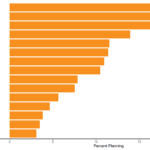5 Things to Know about Potential Impacts of the Coronavirus on Trade and Remodeling

Executive Summary:
- The impact of the virus is going to hit different manufacturing areas in China with varying degrees of severity
- Remodeling and improvement products are manufactured in many other countries including domestically in the US
- After a temporary shock, it’s very common for industries and economies to bounce back at an even higher rate, making up for the temporary loss to output
There are two key points to know about the coronavirus and its potential impact on the remodeling supply chain. First, the overall impact itself is likely to be limited; second, where there is an impact, things will bounce back relatively quickly.
Here are five reasons why:
#1 China has Multiple Industry Dense Areas
The outbreak of the flu itself is centered in Wuhan in Hubei province, a manufacturing heavy area about 500 miles west of Shanghai.

While Wuhan is an industry dense area, it is by no means the largest or most important across China, coming at 9th largest for manufacturing employment and 13th by overall density of manufacturing as a source of total regional employment.1
#2 Hubei Itself is not a Hub for Home Improvement Manufacturing
In addition to its relative size, Hubei’s manufacturing activity is not known as a particular specialization of home improvement and remodeling products (think: flooring, siding, veneers, etc.)., but rather its manufacturing includes automobiles, iron and steel, and pharmaceuticals. 2
While many imported goods used in home services do come from across China, there is no particular risk to manufacturing home improvement goods. This means there could be temporary risks of trade flow disruptions, but acute shortages of these goods during or after the outbreak should not be expected.
#3 Lots of Remodeling Products are Manufactured in Other Countries
While China has been in the spotlight for the last several years as a source of many American imports, including many of the products used in remodeling, there are lots of other parts of the world that also manufacturer these important home goods.
Looking at one common commodity, veneer sheeting, which could go into siding, furniture, cabinets, and other parts of the home, Canada remains the largest source of this import to the United States, dwarfing the veneer imports from China. 3


There are other goods such as plywood where China remains the dominant exporter to the U.S., but the key takeaway is that across the entire home service industry, imports into the United States are reasonably well diversified.
#4 We Don’t Know How Consumers Will Respond
The fourth reason impacts will likely be limited is that ultimately, we do not know how consumers are going to respond.
On the one hand homes are private places and with a widespread attention of disease permeating the public discourse, we may see consumers less interested in the short run in having people come into their homes for any multitude of reasons.
On the other hand, consumers may not draw any connection between a disease outbreak largely concentrated on the other side of the globe to their spending priorities at home.
One thing that is known from past epidemics is that behavior adjustment can be a major source of economic cost when it happens. As research published by the National Institutes of Health notes:
This impact is due not to the consequence of the disease itself for the affected people, but to the impact of the disease on the behavior of many people within these economies…. The true cost of disease is far greater than the cost to a health budget of treatment for the cases involved. 4
So consumer sentiment could temporarily be impacted, particularly if the virus spreads in the United States. But this leads to the fifth thing you should know:
#5 Everything Bounces Back
It’s important to remember that with any major non predicted shift in an industry – whether positive or negative – things usually settle down afterwards to their previous level.
This is a phenomenon economists sometimes call a return to the steady state, where following a shock, an economic series bounces back to it’s normal rate of growth or level of sales at a rapid pace to make up for the shock, and then reverts to its previous trend.

Following the great recession, GDP growth fell dramatically, before increasing at a rapid rate, and then settled back in to a range consistent with its long-term historical trend.5
Another example during the same time period is new car sales, where federal government stimulus and low to 0% financing boosted auto sales dramatically in the period immediately following the recession, before sales made their way back up to their long-term historical average. 6
Takeaways:
There are still a lot of things we don’t know about the coronavirus; while the immediate focus of governmental and non-governmental organizations will be about preventing the spread of the disease and empathizing with those afflicted by it, strategic awareness about what’s going on is also important in order to minimize surprises and disruptions.
The disease may have a limited impact across goods production and global trade flows – which in turn can conceivably spill over into impacting the home services market.
- The disease will have its largest impact in Hubei province, which is a key manufacturing hub in China, but by no means the largest
- Hubei is not a notable cluster for home improvement goods
- Global imports of home service market goods are reasonably well diversified
- Consumer interest in spending could be impacted
- Following many economic shocks, it’s not uncommon for industries and economies to bounce back at a higher growth rate than before to make up for lost time, before returning to their long-term historical average.
Notes and References:
It’s important we remember the most significant part of any issue like this is the human toll. Compassion and empathy for those afflicted should always be front of mind, and never be substituted for financial or economic analysis.
- China Statistical Yearbook, National Bureau of Statistics China
- Trade Commissioner Service, Government of Canada
- Food and Agriculture Organization of the United Nations, FAOSTAT
- National Center for Biotechnology Information, National Institutes of Health
- Bureau of Economic Analysis, U.S. Department of Commerce. via Federal Reserve Bank of St. Louis.
- Bureau of Economic Analysis, U.S. Department of Commerce. via Federal Reserve Bank of St. Louis.
To speak with our Chief Economist about this or other research, please contact publicrelations@homeadvisor.com







 Press & Media Inquiries
Press & Media Inquiries Angi Economics
Angi Economics